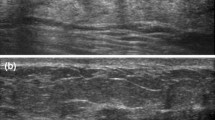Abstract
Background
To evaluate the value of ultrasound-guided vacuum-assisted excision (US-guided VAE) in the treatment of intraductal papillomas, including intraductal papillomas with atypical ductal hyperplasia (ADH), and to evaluate the lesion characteristic features affecting the local recurrence rate.
Materials and methods
Between August 2011 and December 2020, 91 lesions of 91 patients underwent US-guided VAE and were diagnosed with intraductal papilloma with or without ADH. The recurrence rate of intraductal papilloma was evaluated on follow-up US. The lesion characteristic features were analyzed to identify the factors affecting the local recurrence rate.
Results
The local recurrence rate of intraductal papillomas removed by US-guided VAE was 7.7% (7/91), with the follow-up duration 12–92 months (37.4 ± 23.9 months). Of the 91 patients, five cases diagnosed as intraductal papilloma with ADH did not recur, with the follow-up time 12–47 months (26.4 ± 14.4 months). There were no malignant transformation in all 91 cases during the follow-up period. All 7 patients recurred 7–58 months (22.8 ± 19.2 months) after US-guided VAE. There were no significant differences between the non-recurrence and recurrence groups in terms of age, side, distance from nipple, lesion size, BI-RADS category, with ADH, or history of excision (p > 0.05).
Conclusions
US-guided VAE is an effective method for the treatment of intraductal papilloma, including intraductal papilloma with ADH. It avoids invasive surgical excision, but regular follow-up is recommended to prevent recurrence or new onset due to multifocality. Any suspicious lesions during the follow-up should be actively treated.


Similar content being viewed by others
References
Kulka J, Madaras L, Floris G, Lax SF (2022) Papillary lesions of the breast. Virchows Arch 480:65–84
Li X, Febres-Aldana C, Zhang H, Zhang X, Uraizee I, Tang P (2021) Updates on lobular neoplasms, papillary, adenomyoepithelial, and fibroepithelial lesions of the breast. Arch Pathol Lab Med.
Wei S (2016) Papillary lesions of the breast: an update. Arch Pathol Lab Med 140:628–643
Rakha EA, Ellis IO (2018) Diagnostic challenges in papillary lesions of the breast. Pathology 50:100–110
Bennett I, de Viana D, Law M, Saboo A (2020) Surgeon-performed vacuum-assisted biopsy of the breast: results from a multicentre Australian study. World J Surg 44:819–824
Bennett IC, Saboo A (2019) The evolving role of vacuum assisted biopsy of the breast: a progression from fine-needle aspiration biopsy. World J Surg 43:1054–1061
Nakano S, Imawari Y, Mibu A, Otsuka M, Oinuma T (2018) Differentiating vacuum-assisted breast biopsy from core needle biopsy: Is it necessary? Br J Radiol 91:20180250
Wang ZL, Liu G, He Y, Li N, Liu Y (2019) Ultrasound-guided 7-gauge vacuum-assisted core biopsy: could it be sufficient for the diagnosis and treatment of intraductal papilloma? Breast J 25:807–812
Mosier AD, Keylock J, Smith DV (2013) Benign papillomas diagnosed on large-gauge vacuum-assisted core needle biopsy which span <1.5 cm do not need surgical excision. Breast J 19:611–617.
Wyss P, Varga Z, Rossle M, Rageth CJ (2014) Papillary lesions of the breast: outcomes of 156 patients managed without excisional biopsy. Breast J 20:394–401
Kibil W, Hodorowicz-Zaniewska D, Popiela TJ, Kulig J (2013) Vacuum-assisted core biopsy in diagnosis and treatment of intraductal papillomas. Clin Breast Cancer 13:129–132
Funding
This research did not receive any specific grant from funding agencies in the public, commercial, or not-for-profit sectors.
Author information
Authors and Affiliations
Corresponding authors
Ethics declarations
Conflict of interest
The authors declare that they have no conflict of interest.
Informed consent
This retrospective study was approved by our institutional review board, and the requirement to obtain informed consent was waived.
Additional information
Publisher's Note
Springer Nature remains neutral with regard to jurisdictional claims in published maps and institutional affiliations.
Ping He and Yu-Tao Lei are co-first author.
Rights and permissions
Springer Nature or its licensor (e.g. a society or other partner) holds exclusive rights to this article under a publishing agreement with the author(s) or other rightsholder(s); author self-archiving of the accepted manuscript version of this article is solely governed by the terms of such publishing agreement and applicable law.
About this article
Cite this article
He, P., Lei, YT., Chen, W. et al. Ultrasound-Guided Vacuum-Assisted Excision to Treat Intraductal Papilloma. World J Surg 47, 699–706 (2023). https://doi.org/10.1007/s00268-022-06735-2
Accepted:
Published:
Issue Date:
DOI: https://doi.org/10.1007/s00268-022-06735-2



